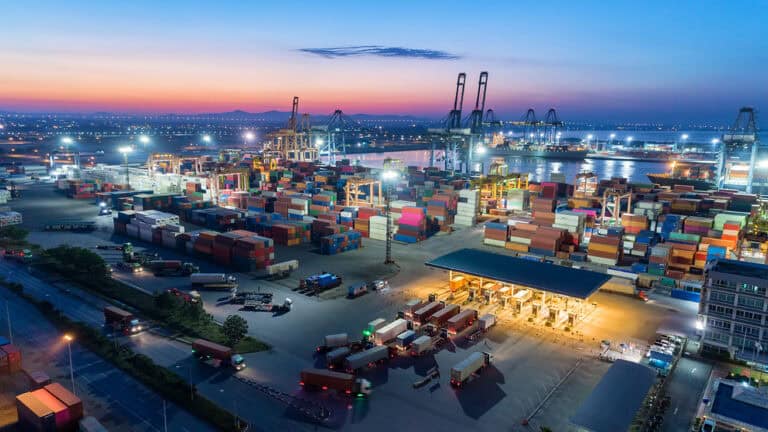
As I was returning home to the United States from the Connect Europe 2024 customer event a few weeks ago, I reflected on the significance of “staying connected” and the importance of transparency across the globally distributed supply chains I heard about from our customers and integration partners who presented at the event.
The very doors at the hotel conference center bear the name of a customer that produced the locks, the sound systems made by another major company, and microchips – potentially thousands of them – powering our laptops, video screens, mobile devices, and taxi cabs – supplied and distributed to other brands who use them to build these things.
The intricate web of connections behind these everyday items is mind-boggling, but disruptions can quickly split the delicate threads that keep goods moving. Connected supply chain technology is the most reliable solution to avoid the unmanageable and the critical glue that can hold those threads together. Here’s why.
Six decades of global trade stability comes to an end
The world, global commerce and culture, and the supply chains keeping everything going have experienced a mix of stability and challenges in the last 60 years. Still, overall, there have been no significant disruptions. Despite regional conflicts and occasional tensions, the world has primarily avoided large-scale global wars since World War II. Technological advances, trade liberalization, and globalization have increased prosperity for many nations, leading to economic growth and development. The internet, mobile communication, and digitalization have connected people globally and revolutionized various sectors. While there has been progress, environmental issues remain a critical challenge. Climate change, deforestation, and pollution threaten our planet’s stability. Heightened awareness of the systemic discrimination of marginalized groups across various domains has led to social responsibility legislation and policies.
The Covid-19 pandemic profoundly affected global health and economies; however, the US government’s trade wars disrupted international trade relations even before they hit. The “tariff wars” shook the foundations of global trade by imposing steep duties on billions of dollars worth of goods from the EU, Canada, Mexico, and China. These countries retaliated with levies on thousands of US products. Both events have far-reaching consequences that continue to shape our world. The broad mindset of distrust in Chinese manufacturing has permeated, and political pressure continues to restrict the availability of parts, components, and finished goods from the region.
The geopolitical landscape is shifting, and the pandemic has further complicated matters. Leaders are grappling with how to advance global stability and peace in this uncertain environment yet still protect their own nations’ interests through protectionist policies. The World Economic Forum’s Annual Meeting in 2022 highlighted the most consequential geopolitical and geo-economic moment of the past three decades. Russia’s invasion of Ukraine signaled the emergence of a new era with global implications.
Extreme weather events have significantly impacted global supply chains, often leading to disruptions that can have far-reaching consequences. These extreme weather events lead to delays in the movement of goods, affecting supply chain timelines. When transportation routes are disrupted, companies may need to reroute shipments or use alternative modes of transport, resulting in higher shipping costs. When extreme weather events disrupt production facilities, warehouses, or distribution centers, there can be shortages of essential goods. Supply chains are often global, with components sourced from various countries. A single point of failure, a single supplier or production location, can disrupt already fragile supply chains.
A connected supply chain overcomes traditional barriers
The need for a globally-connected supply chain system is more apparent than ever. In today’s globalized economy, supply chains play a critical role in ensuring the efficient movement of goods from manufacturers to end consumers. However, traditional supply chain models face challenges such as fragmentation, inefficiencies, and lack of real-time visibility. Organizations are increasingly turning to connected supply chain technology to address these issues.
- An innovative, connected supply chain technology platform improves cross-functional collaboration from end-to-end, improves decision-making by gathering data from a broad and deep network of ecosystems, leverages sophisticated artificial intelligence and machine learning (AI/ML) to optimize actions, and automates, when possible, to enhance efficiency and build resilience.
- As consumer expectations continue to evolve, supply chains must adapt. Connected technology enables real-time tracking, predictive analytics, and responsive decision-making to meet rising demand efficiently. Whether it’s same-day delivery, personalized product recommendations, or transparent order status, connected supply chains enhance customer satisfaction.
- A typical global shipment involves multiple stakeholders: manufacturers, carriers, ports, retailers, and more. These interconnected entities need seamless collaboration – especially since they operate out of the four walls of your organization. Connected supply chain technology bridges the gaps, allowing stakeholders to share data, optimize speed, risk, and cost, and synchronize operations.
- Connected supply chains allow for holistic decision-making. Instead of isolated decisions within silos, organizations can optimize the entire network. Data-driven insights help identify bottlenecks, optimize routes, and allocate resources effectively. Connected technology enables real-time visibility, allowing rapid adjustments when unexpected events occur.
Physical and digital supply chain twins
In summary, the connected supply chain is our best defense against the unmanageable complexities of modern commerce. We can navigate the challenges ahead by staying connected, embracing technology, and prioritizing resilience. By adopting connected supply chain solutions, organizations can thrive in an increasingly complex and competitive environment.
At our European customer event, global manufacturers, shippers, and transporters formed synergistic relationships. The physical connections between diverse people working in equally varied industries embodied e2open’s digital supply chain twin. Collaboration ignited relationships, and now the digital connections will continue to keep supply chains moving as one.
If you would like to learn more about how your business could benefit from connected supply chain solutions, please contact us.







